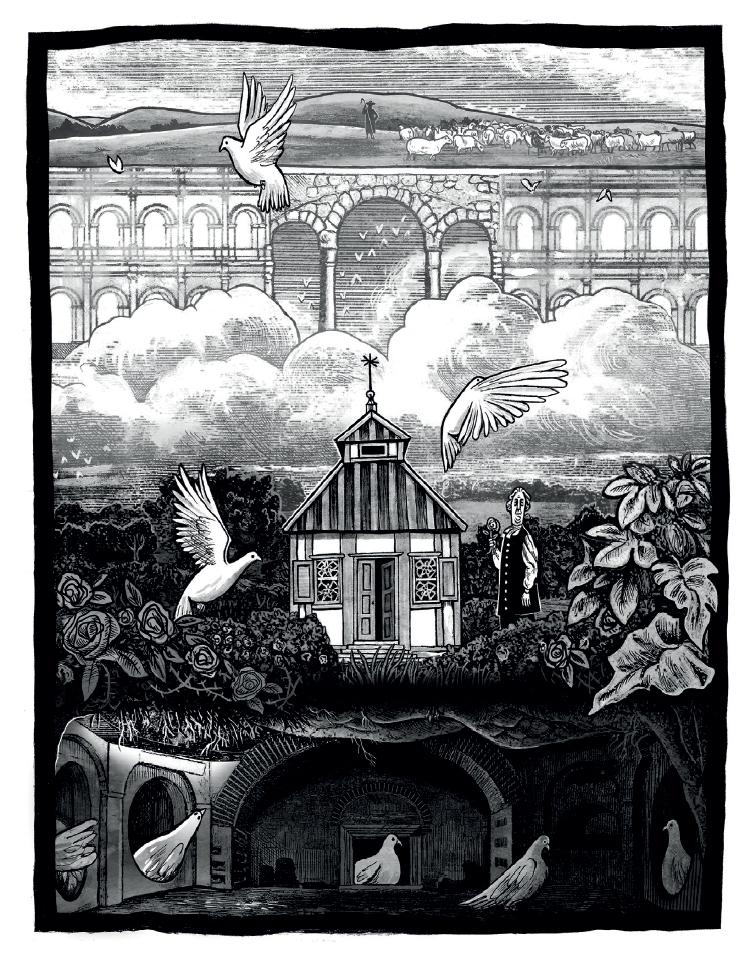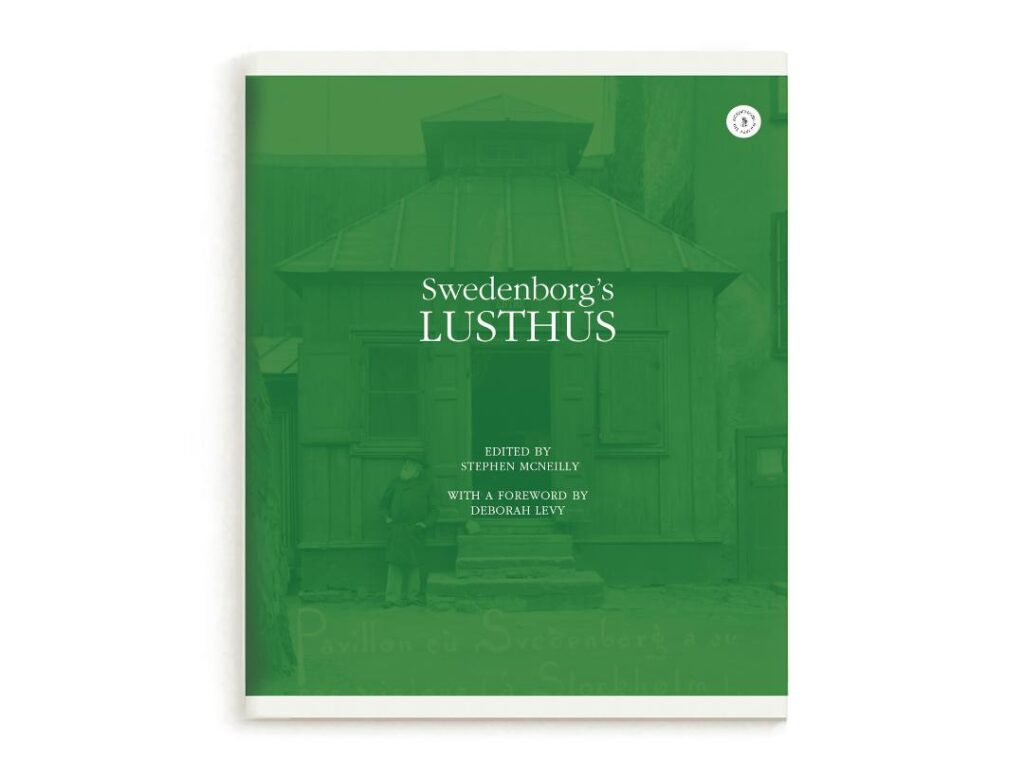
Poster: Ben Wickey
On SWEDENBORG’S LUSTHUS (The Swedenborg Society, 2024. Ed. Stephen McNeilly)
This is a special book made from a semblance of shadow;
Being Stephen McNeilly’s curation of much of what Swedenborg
Still bestows. As a collection is made from artist visitations
To Emanuel’s Stockholm eyrie, in which an 18th Century shed
Becomes sacred as we in the present get to see and sense
All we owe. Starting with Iain Sinclair, McNeilly’s mix sent
To Sweden included Bridget Smith, Ken Worpole,
Anonymous Bosch, Chloe Aridjis, Ben Wickey, with Arne Bionstad
And Hjalmar Gullberg as Swedes themselves closer still,
In order to examine the room in which Swedenborg sifted spirits,
Just as Strindberg later, attempted gold from bath swill.
But in this book, visions swirl as each practitioner finds perfection
Through both their responses and the aura still resident in the air.
Which can be sensed from Deborah Levy’s introduction,
Whose scented words have for decades made each page
She has spun gold and glare. One inhales her books
And her plays as she prepares the ground for our reading,
As her summerhouse treatise ‘Angels and Other Things’
Weaves its spell. In which Levy relates her personal tour
Of word shelters, from North London to Paris and on,
To Aegina, where, watching close and writing glazed
By sun and by silence, she sees ‘God in a squirrel’
And works from ‘the end of love ..to elation’ and all
In the context of Swedenborg’s Lusthus as perfect patina.
It starts this beautiful tome, sensual to the touch,
A green shadow, with its Greek Yoghurt-like pages,
And seductive Quinn Fizzlers design, sheltering like a shed
These time-bridging contents; each page is a wall made
For mounting that which becomes possible now to define:
Some sublime sense of place and of the memories held
Within it, for just as mirrors store reflections (or so it is said)
So, these stories through either pen or lens seem to find
Their way back to the source. As Ken Worpole studies Poetics;
Tracing the time and tide between these garden temples
With his Historian’s skill; line as mind. And where Architecture
Naturally, becomes city landscape and texture, and where
These sheds make cathedrals of whatever scale, Gods to find.
‘The Poetics Of Small Spaces’ is pure tract, making deities
From domestics, dedicated reconstructions are reflections
Always, shadows torn from the light left by trees
Which centuries on still observe us, and who once moved
While the writing that spurred this Society on was first sworn
And thus, sanctified, as with Bridget Smith’s green room
photos, in which wall and table are temple and Upstage
Centre window is a stained glass frieze of Oiled trees.
Painted by God, or by Emanuel’s spirits, who in arranging
Nature now nurture the tale’s mysteries. Selected now
By Sinclair whose prose is both Saint and Serpent, moving
Myth with word muscle, as his sinous style sets ghosts free.
As he details his journey this time, Sinclair scoops up
Found flavours, from Mary Woollstencraft, Ingmar Bergman,
Gomez Barcena, Arthur Machen, M. Moorcock, his stormcock
Bidding and ready to ride each strong wind, carried across
London air and into the Scandanavian without effort, as ghosts
In the garden linger amused by our sins, which Sinclair,
As a former landscape gardener also saw, as he moved
From books to roses and back to books, blooming in him.
Swedenborg remains template, and the Lusthus recreation
Is needle in the tempest eye of thought’s storm. Sinclair
When he writes always unifies with his subject, drawing all,
As a wormhole, there are no divisions between him talking
To us and where Swedenborg sat. Ghosts grow warm.
As these two men share a seat, even as Sinclair’s walking
o him. Swedenborg’s conversations with Angels
And with possible Devil’s too taints the page. As the past
Is unearthed and the spirit soil freshly tendered,
Reverence and reference fusing, so that this new Lusthus
Is authentic and set once more for art’s stage. Suitably,
The Strindbergian strain is now Anonymous Bosched
Into being, as his stunning photographs capture
Not only the shed, but the time, as his pinhole camera
Points to the past with uncanny perfection, as this would
Have been the way to see Emanuel, August, and Henrik,
And William too, through light’s line. The pictures seem
To shimmer and shake, despite their relative darkness.
They seem as rushed and as settled as each and all memory.
Transporting you back one world, or maybe three or four,
Until you’re standing with Swedenborg in 1747, and in so doing,
Becoming your own death’s enemy. Each page is a portal
Once viewed. And that is the idea of this volume.
A gallery for the reading and communion with the past.
As Chloe Aridjis essays in her first person stories
Of Skansen Summerhouse Guide, site sprite Hustomte,
And elder Poet, a trio of voices from which her time
Tainted tales have been cast. Aridjis defines the legacy
Of our mystic whose links with London have been declared
By Sinclair. But these three voices explore the influence
Of location, and of invocation as Emanuel urges all, like a dare
To become something else, as Aridjis does with her writing,
For by blending beings Swedenborg’s scope is revealed,
Implying of course the need for insistence that many more
Should know of him, for just as this society teaches,
So the cultural surround still conceals. General ignorance
Overwhelms. So a return to such rooms become crucial,
For within them, the ritual from which writing breaks forth
Splits the seal of convenience stamped by the narrow
Minded. Swedenborg is Sophocles, Schulz and Stoker.
He is Alan Moore, Borges, and any magus, whose wall
Becomes your mind screen. Salinger refused to share his,
But the ritual remains to be savoured. It is there
In Gullberg’s Lusthuset poem and in Biostad’s restorative
Photos, which see the Lusthus recreated: monochrome
Studies which somehow show garden green. McNeilly’s elegant
Essay concludes. taking us through the grounds of Skansen’s
Open air light musuem, the current set for Swedenborg’s
Visions, and where is perfect play is performed. We receive
The books rationale, which bares endless iteration:
As this is a man and a magic and a myth as well to transform
Every line, light and life, uniting all nations. In city,
Or country, garden or grave, we align. It is there in Deborah
Levy’s idea and in the history Worpole details. It is in Iain
Sinclairs starred connections, Aridjis’ actors and in Bosch’s
Kidnapped time. Ben Wickey’s poster cartoons and brings
Swedenborg back before us. Emanuel’s Bibliography bibles
As the room is returned. Page as sign.
David Erdos 31/1/24

https://www.swedenborg.org.uk/product/swedenborgs-lusthus/
https://www.swedenborg.org.uk/events/exhibition-swedenborgs-lusthus/
.
